CONSTELLATION GUIDE
Last updated: 19 September 2001
CONSTELLATION GUIDE |
"GO TO"....CAMELOPARDALIS, a celestial "Giraffe"
....say what?? Is it a Giraffe....or is it a Camel? What's in a name.....Let's take a look:
From: sherrodc@ipa.net (Clay Sherrod)
This is the 27nd Constellation Guide, "GO TO CAMELOPARDALIS" of the series "GO TO GUIDES for the ETX and LX 90 Telescope Users". So let's get the obvious out of the way early.....how many of you have actually ever even LOOKED into Camelopardalis....how many can actually point out where it is in the sky??
Not many, I'll bet, and when you look at the list of the brightest stars of this faint but large constellation, you can clearly see WHY you have not visited the giraffe pen any more often.
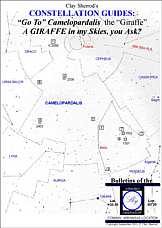
However, you have been missing out on some fantastic deep sky objects and some wonderful multiple stars if you have ignored the constellation as you will quickly realize from our chosen listing of interesting or unusual objects below.
Camelopardalis (pronounced "camelo-PAR-duh-lis") has no named star. Indeed, its primary (Bayer, Greek alphabetized) stars are comprised of stars ONLY magnitude 4.2 and fainter! You can see just how faint this constellation really is by looking at my complete listing below:
|
Bayer ref |
Flamsteed no |
GCVS ref
|
GCVS no
|
SAO no
|
Max mag |
Comp sep
|
RA hr |
RA min
|
RA sec
|
DEC +-
|
DEC deg
|
DEC min
|
DEC sec
|
Pos err
|
|
alp |
9 |
|
|
13298 |
4.29 |
|
4 |
54 |
3.03 |
+ |
66 |
20 |
33.61 |
3.799 |
|
bet |
10 |
|
|
13351 |
4.03 |
80.8 |
5 |
3 |
25.096 |
+ |
60 |
26 |
32.06 |
3.317 |
|
gam |
|
|
|
5006 |
4.63 |
106.3 |
3 |
50 |
21.513 |
+ |
71 |
19 |
56.2 |
4.477 |
|
|
1 |
|
|
24672 |
5.77 |
10.3 |
4 |
32 |
1.821 |
+ |
53 |
54 |
39.06 |
3.516 |
|
|
2 |
|
|
24744 |
5.35 |
0.3 |
4 |
39 |
58.095 |
+ |
53 |
28 |
23.26 |
3.787 |
|
|
3 |
|
|
24743 |
5.05 |
3.8 |
4 |
39 |
54.709 |
+ |
53 |
4 |
46.58 |
3.758 |
|
|
4 |
|
|
24829 |
5.3 |
99 |
4 |
48 |
0.284 |
+ |
56 |
45 |
26.01 |
3.389 |
|
|
5 |
|
|
24904 |
5.52 |
12.9 |
4 |
55 |
3.12 |
+ |
55 |
15 |
32.93 |
3.82 |
|
|
7 |
|
|
24929 |
4.47 |
0.4 |
4 |
57 |
17.18 |
+ |
53 |
45 |
7.64 |
3.483 |
|
|
8 |
|
|
24943 |
6.08 |
|
4 |
59 |
46.314 |
+ |
53 |
9 |
19.82 |
3.818 |
|
|
11 |
BV |
110099 |
25001 |
5.08 |
180.5 |
5 |
6 |
8.467 |
+ |
58 |
58 |
20.53 |
3.393 |
|
|
12 |
BM |
110090 |
25003 |
6.18 |
180.5 |
5 |
6 |
12.169 |
+ |
59 |
1 |
16.17 |
3.297 |
|
|
14 |
|
|
13413 |
6.5 |
|
5 |
13 |
31.283 |
+ |
62 |
41 |
28.78 |
4.097 |
|
|
15 |
|
|
25125 |
6.13 |
|
5 |
19 |
27.838 |
+ |
58 |
7 |
2.19 |
4.093 |
|
|
16 |
|
|
25161 |
5.28 |
106.2 |
5 |
23 |
27.614 |
+ |
57 |
32 |
39.6 |
3.959 |
|
|
17 |
|
|
13518 |
5.42 |
|
5 |
30 |
10.207 |
+ |
63 |
4 |
2.17 |
3.7 |
|
|
18 |
|
|
25241 |
6.48 |
|
5 |
32 |
33.824 |
+ |
57 |
13 |
16.22 |
3.682 |
|
|
19 |
|
|
13550 |
6.15 |
1.6 |
5 |
37 |
15.123 |
+ |
64 |
9 |
16.64 |
3.991 |
|
|
22 |
|
|
25298 |
6.9 |
|
5 |
39 |
5.445 |
+ |
56 |
21 |
36.33 |
3.415 |
|
|
23 |
|
|
13590 |
6.15 |
|
5 |
44 |
8.578 |
+ |
61 |
28 |
35.51 |
3.2 |
|
|
24 |
|
|
25333 |
6.05 |
|
5 |
43 |
1.647 |
+ |
56 |
34 |
53.68 |
3.527 |
|
|
26 |
|
|
25362 |
5.94 |
|
5 |
46 |
30.399 |
+ |
56 |
6 |
56.41 |
3.72 |
|
|
29 |
|
|
25403 |
6.54 |
25.1 |
5 |
50 |
34.023 |
+ |
56 |
55 |
7.83 |
3.684 |
|
|
30 |
|
|
25419 |
6.14 |
|
5 |
52 |
17.361 |
+ |
58 |
57 |
50.57 |
3.445 |
|
|
31 |
TU |
110028 |
25447 |
5.12 |
|
5 |
54 |
57.79 |
+ |
59 |
53 |
17.96 |
3.684 |
|
|
36 |
|
|
13756 |
5.32 |
|
6 |
12 |
51.073 |
+ |
65 |
43 |
6.3 |
4.769 |
|
|
37 |
|
|
25597 |
5.36 |
|
6 |
9 |
59.095 |
+ |
58 |
56 |
8.94 |
3.777 |
|
|
40 |
|
|
13772 |
5.35 |
102.7 |
6 |
15 |
40.638 |
+ |
59 |
59 |
56.82 |
3.16 |
|
|
42 |
|
|
13973 |
5.14 |
|
6 |
50 |
57.146 |
+ |
67 |
34 |
18.88 |
4.298 |
|
|
43 |
|
|
13986 |
5.12 |
|
6 |
53 |
42.246 |
+ |
68 |
53 |
17.74 |
4.571 |
|
|
47 |
|
|
26298 |
6.35 |
2.2 |
7 |
22 |
17.225 |
+ |
59 |
54 |
7.28 |
3.308 |
|
|
49 |
BC |
110081 |
14322 |
6.43 |
|
7 |
46 |
27.433 |
+ |
62 |
49 |
50.15 |
3.862 |
|
|
51 |
|
|
14321 |
5.92 |
|
7 |
46 |
40.182 |
+ |
65 |
27 |
20.84 |
3.065 |
|
|
53 |
AX |
110077 |
14402 |
5.95 |
|
8 |
1 |
42.343 |
+ |
60 |
19 |
27.67 |
3.615 |
Camelopardalis is NOT one of Ptolemy's original 48 constellations, but a very faint group of "lost stars" that was stranded somewhere in between Cassiopeia to the west and Ursa Major to the east. Immediately NORTH of this sprawling stellar "wasteland" is the north celestial pole and the brighter star Polaris. It is one of the most recent additions to constellations, added by the German astronomer Bartsch.
Wherever his source might have been Bartsch recognized this star pattern (after two millennia of being neglected from Ptolemy's famous four-dozen) as the "camel" of Biblical fame that was responsible for safely bringing Isaac from across the vast middle east to his awaiting Rebecca. Thus, the name is somewhat "close" to representing that story concept....but the actual translation of the word "Camelopardalis" to modern scripts reflects a GIRAFFE, not camel. Hence, earliest star tables such as the 1690 star chart by HEVELIUS (shown below) show something more of the long-necked creature.
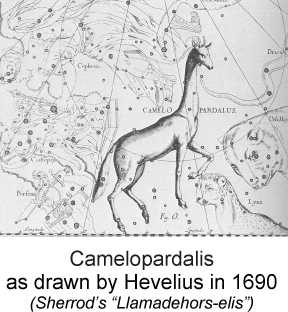
Now...I ask the question: does Hevelius' drawing look anything LIKE a "giraffe?" We know the answer to that is: "..other than the long neck, NO." So...does it look like a "camel?" Clearly the answer to that is "NO." What it actually appears to be (at least to these old star-strained eyes) is a cross between a Llama and a horse...sort-of a "Llamadehors-elis".
Another interesting note about this figure from Hevelius' old star catalog is his nature of rendering ALL star patterns and associated creatures/figures such as this. Compare (if possible) his drawing of key stars to those stars shown in my star chart above. They are REVERSED! All of Hevelius's charts were so drawn to represent how the star patterns would look if you were LOOKING BACK toward the EARTH, actually through the stars and toward the Earth. Very interesting....that would, indeed be quite difficult of today's modern GO TO telescopes, would it not?!
This constellation is another one of the CIRCUMPOLAR CONSTELLATIONS of northern skies, just as is Cassiopeia, featured in this series of "GO TO" constellation tours. This means that - from mid-northern latitudes of about 35 degrees and higher MOST of the stars of this large constellation neither rise nor set below any horizon, only spin around in apparent circular paths centered on the north celestial pole.
Camelopardalis is highest in the sky on midnight, November 15 and lowest (closest to the northern horizon, between Polaris and the horizon) on May 15. It is a very difficult constellation pattern to recognize, even through wide field photographs, and much imagination must have been used by Bartsch when he so designated this faint collection of stars to be either a Biblical "camel" or another animal NOT mentioned anywhere in the scriptures: a "giraffe."
To the naked eye, this constellation might appear at first a bit uninteresting, as there are no very bright stars nor conspicuous asterisms (star patterns) on which to focus your attention; nonetheless, there is an absolute WEALTH of nice deep sky objects (two nice planetary nebulae, by the way!) and many, many great double stars, only a few of which can be covered here. For a very complete listing with abbreviated details concerning nearly 100 multiple stars in this constellation, turn to my favorite guide: BURNHAM'S CELESTIAL HANDBOOK, Vol. One in which you will find the constellation listed alphabetically with the comprehensive multiple star listing at the beginning of the chapter on Camelopardalis.
As with every "GO TO" TOUR guide, each GO TO object in Camelopardalis is discussed for your telescope regarding the type of conditions necessary for you to view it optimally for discern the very faintest details.........magnifications and aperture necessary for most objects, and much, much more. This is YOUR complete GUIDE to get you on your way to exploring the best (and few!) objects in this constellation. The following listing of "BEST" objects contains the finest or most interesting from my own observing experience and preference.
Use the attached star chart and the following Guide as an excellent reference for your next star party itinerary, or a beginning for further study into the thousands of objects visible in this part of the sky. Truly these extensive Constellation Study Guides will most definitely put your AutoStar to work for you in the most efficient and enjoyable way possible! As a matter of fact, MANY AutoStar users are now programming their own "Tours" based on these guides, using each constellation as a separate GO TO Tour for the AutoStar library that can be added in or deleted through the main edit screen on your PC or MAC computer.
We hope you enjoy these comprehensive GUIDES to touring the constellations via your AutoStar and its computer-driven telescope. Each new installment is complete with diagrams, charts and illustrations that you will find nowhere else. Please let us hear YOUR feedback and your observations of each and every constellation after YOU have toured its vast reaches of our skies!
-----------------------------------
YOUR CAMELOPARDALIS CONCISE DIRECTORY OF INTERESTING OBJECTS -
I have chosen the finest (or most interesting) 11 objects in this CAMELOPARDALIS "GO TO" TOUR; as with all GUIDES, all objects listed below will be visible in most telescopes (NONE naked eye in this installment, as there are no deep sky objects in Camelopardalis visible even in a pair of 7 x 50 binoculars....a fact that is also quite unique to this faint and largely-ignored constellation) Larger apertures may "show" an object a bit closer and "better," but frequently a wide field and low power view is more desirable than aperture for FINDING the objects initially. Indeed, I strongly encourage you first FIND the target object, or its approximate location through your GO TO function with your lowest power and then - once IDENTIFIED positively - move up slowly in steps with magnification if necessary. Remember, not all objects "like" magnification. Sometimes better "field of view" (such as the wonderful wide fields provided by the ETX 60 and 70) is desired over light gathering (like the big LX 90) and magnification.
The rule for determining "optimum magnification" is that: 1) too low power results in sky background glow detracting or diminishing the contrast against the deep sky object; 2) too high magnification darkens BOTH the sky background AND the object; 3) medium magnification can be achieved at which you have MAXIMUM contrast between the object and its darkened background sky. I have found through three decades of direct observing that about 15x per inch aperture (36x for the ETX 60/70; 55x for the ETX 90; 75x for the ETX 125; and, 125x for the LX 90).for deep sky observing is PERFECT for most objects. That being said, always remember that DOUBLE or multiple stars require whatever power you can crank out....the seeing conditions are the limiting factor here.
For my complete and comprehensive discussion regarding seeing conditions and sky transparency, see: http://www.weasner.com/etx/buyer-newuser-tips/seeing.html .
With all deep sky objects, avoid attempting to observe when the moon is in the sky, even a very thin crescent, as its brightness in the sky will overshadow the very dim contrast afforded by even the brightest deep sky object; if you see the object at all against moonlight, you will NOT see the subtle outlying areas or the full detail of what is presented.
As with all of the "GO TO" TOUR constellation lists, I recommend a good star atlas and/or chart which will list all the finest objects, constellation-by-constellation. One very handy reference guide is the PETERSON FIELD GUIDE TO THE STARS AND PLANETS, which features complete lists with declinations, right ascensions, magnitudes, and all pertinent information for you to expand your observing horizons beyond this brief GUIDE.
Note that your AutoStar will NOT have every object listed on every constellation GO TO tour....this is intentional. You can access some of the most interesting objects of the sky directly from their coordinates. It is quite simple as you merely enter these coordinates as follows in the 10-step process:
1) Press the "MODE" key and hold down for 3 seconds and release;
2) Displayed will be the current Right Ascension and Declination of the center of field of view of where your telescope is presently pointed (assuming that you have properly aligned from "home position");
3) [NOTE: if you have the Meade electric focuser attached to any of the ETX or LX telescopes, holding down the "MODE" key will bring up the "Focus" command first....merely scroll (lower right scroll key) down one step to access the RA and DEC to enter your desired coordinates]
4) Press the "GO TO" button on AutoStar;
5) This will change the display and you will note the cursor blinking over the first digit of RIGHT ASCENSION (R.A.); merely use the number keys and dial in the R.A. of the object you are searching for;
6) When done, press "Enter;"
7) This moves the blinking cursor over the "DEC" coordinates;
8) [NOTE: the declination, unlike R.A., can be either positive or negative and you will see the "+" or "-" sign displayed depending on where your telescope is aimed at that time; if it is NOT the desired setting (plus or minus), merely use your arrow key to move the blinking cursor OVER the "+" or "-" sign and change by using either of your lower corner SCROLL KEYS;
9) Proceed to enter the DEC using number keys;
10) Press either "Enter" or "Go To" when finished and the telescope begins slewing to your desired object!!
The constellation tour Star Chart above (click on and save to a file on your PC; then open it and re-size to fit the page and print for a very handy at-the-scope star chart) will get you started on your journey for this constellation.
Following is the concise object list for your "GO TO" TOUR of CAMELOPARDALIS; you may wish to find the majority of the objects from the AutoStar Library (for example, you can easily go to the nice planetary nebula ngc1501 if you pull up "Object/Deep Sky/NGC/..then type in '1501'...." and then press "Enter", followed by "GO TO" to access this object. On the other hand, if you want to experiment and become a "better AutoStar user" try entering the exact R.A. and DEC coordinates of that object as described above after holding down the MODE key. You will find the accuracy of entered GO TO's to be somewhat less than those stored in AutoStar, but the capability of acquiring unlisted objects is fantastic!
You will access your FIRST GOTO target - (usually the brightest star in each constellation) - different that we normally do in our "GO TO" TOURS, since Camelopardalis has NO "named" star! Instead, we will go to "ALPHA CAM" via the Right Ascension and Declination that you will enter just as described above! That will be a first for you, in all likelihood. If you don't first access this 4th magnitude star via entering its coordinates as provided in the following listing.....KEEP TRYING! !
You may also access the constellation by: SETUP / OBJECT / CONSTELLATION / Camelopardalis... Enter....GO TO.
OBJECT 1:
bright star - alpha Camelopardalis ("Alpha Cam") - R.A. 04h 49' / DEC + 66 16' - Magnitude: 4.4
OBJECT 2:
nice bright double - 2 Cam (Struve 385) - R.A. 03h 25' / DEC + 59 46 - Mags. 4.5 & 9 - A "fun" test
OBJECT 3:
triple star - Kuiper 16 - R.A. 04h 19' / DEC + 59 30 - Mags: 6, 10.5, 8.1 - A wonderful object!!
OBJECT 4:
test triple - 7 Cam - R.A. 04h 53' / DEC + 53 40 - Mags: 4.5, 8, 11 - challenge for a 5" scope!!
OBJECT 5:
super variable - S Cam - R.A. 05h 36' / DEC + 68 46 - Mag. 8.1 to 11.0, 326 days!
OBJECT 6:
very erratic star! - Z Cam - R.A. 08h 20' / DEC + 73 17 - Mag 10.1 to 13.0....a WILD ride!!
OBJECT 7:
nice galactic cluster - ngc1502 - R.A. 04h 03' / DEC + 62 11 - Mag. 5.3! 15 stars, VERY small!
OBJECT 8:
nice spiral galaxy - ngc2403 - R.A. 07h 32' / DEC + 65 43 - Mag: 8.8, VERY large....nice!
OBJECT 9:
nice spiral - ngc2336 - R.A. 07h 16' / DEC + 80 20 - Mag: 11.0 - spiral arms can be seen!
OBJECT 10:
faint planetary nebula - ngc1501 - R.A. 04h 03' / DEC + 60 47 - Mag: 13.3 w/ 13th mag. star!
OBJECT 11:
another planetary - IC3568 - R.A. 12h 34' / DEC + 82 51 - Mag. 11.6 w/12th mag. star. Near Polaris!!
---------------------------------
A VISUAL GUIDE TO OUR DEEP SKY OBJECTS IN CAMELOPARDALIS
Object 1 - Our "Starting" Star - alpha Camelopardalis
You will have to use your knowledge of Autostar to find this one! Alpha Cam is an un-named 4.4 magnitude star that you likely would NEVER look at if it were not for this "TO TO" TOUR! Enter the R.A. and DEC coordinates above as described early in this Guide into the Autostar and press "GO TO" to zero in on this rather uninteresting and uneventful star. It is NOT double....it is NOT variable...it does NOT have an distinctively pretty color....it IS, however, a very "early" type "O" star, very hot and bright white at a distance of some 1,000 parsecs from our solar system, more than 10 times more distant than any other brighter star in Camelopardalis!
Object 2 - Double Star "2 Camelopardalis" (also known as Struve 385)
There is a bit of history in this star as it was one of the first to be cataloged as "double" by Sir William Herschel in the 18th century with his "40-foot Reflector" (see my article about this scope at:
http://www.weasner.com/etx/fun/herschel.html ). This is a very nice for the ETX 90 and larger telescopes, with a clear separation of about 2.3" arc. The primary star is a relatively bright magnitude 4.5 while the companion star (nearly due south from the brighter one) is a faint magnitude 9.1. Both stars are blue-white, and were re-cataloged by W. Struve early in the 19th century. With the difference in brightness, this is a nice star for all scopes, since it is NOT as easy as it first may look!
Object 3 - Kuiper 16 - A Fine Triple Star
Here is a tough test for even the ETX 125 and certainly the ETX 90; although the two main components ("A" and "B") are a full 1.3" arc and should theoretically be resolvable through a good 3" scope, I have found this a particularly difficult pair to cleanly split because of a great difference in brightness. The first two stars (1.3" arc apart) are magnitudes 6.2 and 10.3 (!), with the fainter star seemingly VERY close nearly DUE SOUTH of the 6th magnitude star, and just a little bit west. The third component - a true gravitational triple - is found much farther away and is MUCH easier to see! Look for this "C" component nearly NORTH EAST from the brightest star "A", a whopping 32" arc away....that is slightly less than the entire width that Jupiter would appear in the same eyepiece. To see the tough pair ("A" and "B"), use very high magnification in the 3" and larger scopes (about 40x per inch aperture minimum); the distant "C" component will be much easier (you can spot it with the ETX 70 easily) using medium power (about 20x per inch aperture). All three stars are "early spectral type-A" stars, very brilliant yellow-white.
Object 4 - Another Triple Star! 7 Cam - Provides Quite a Test for the 5" Telescope!
Here is a triple star that will be a challenge for all scopes 5" and larger. This is a true triple star that is moving through space with a common proper motion. The odds are stacked against you to see all three components, but it CAN be resolved into all three components in a 5" scope theoretically; I have never been able to see all three stars in any 6" Newtonian telescope, but have cleanly resolved all in a good 6" refractor on steady nights using about 300x. In all respects, it should not be a problem with an 8" or larger scope, but still an interesting challenge! Here is the problem with this star.....see if YOU can overcome the odds! (refer to my chart below:
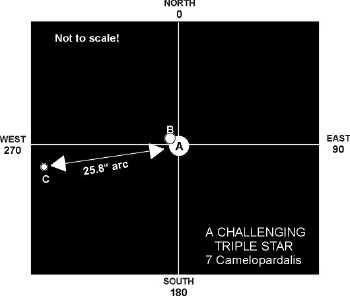
1) Components "A" (primary) and "B" are separated ONLY by 0.9" arc, the exact theoretical resolution limit of a perfect 5" aperture telescope. However, it gets harder. There is a huge magnitude difference when you add that to the proximity of these first two stars. "A" is magnitude 4.4 and "B" is magnitude 8.1, thus the brighter star tends to overshadow the secondary "B" star. Look for the fainter of these two in Position Angle 285 degrees, or nearly due WEST of the brighter star.
2) Component "C" adds insult to injury....it is far enough away to be easily seen in the ETX 90 and larger (26" arc - about the size of Mars' disk in the same eyepiece) BUT it is magnitude 11.2! So carefully look for this fainter companion star to the other two in Position Angle 240 degrees (just south of due west) fairly far from the primary, nearly in the same angle as the "B" star is offset.
Object 5 - A Very Nice "Year-long" Variable Star - S Camelopardalis
To observing this star, you will need two star charts from the American Association of Variable Star Observers (AAVSO - www.aavso.org) , the "finder" chart - a low power, wide field chart to help you locate the star the first few times out as well as make magnitude estimates when it is at its brightest - known as "b chart"; this chart can be downloaded from: charts.aavso.org/standard/CAM/S_CAM/SCAM-B.GIF ; next, for observing the star when faintest you will need a narrow field, faint-comparison-star chart ("d chart") providing stars below 11th magnitude. This chart is located at:
charts.aavso.org/standard/CAM/S_CAM/SCAM-D.GIF . Note that both of these AAVSO charts are NOT reversed as you will see the field in a catadioptic telescope through a diagonal mirror; thus the fields will appear upside down and reversed and may take a bit of getting used to.
On all AAVSO charts, they are free for the downloading and you merely save them to file on your computer, call up the file once done and resize (they are huge when you download!) and save again in an appropriate size; then merely print them out for use at the telescope!
S Camelopardalis is a Long Period Variable, ("LPV" - see my complete discussion on variable star observing and star types at: http://www.weasner.com/etx/ref_guides/variable_stars.html ) but is an interesting one in that it is not really all that predictable as to its light curve....see the chart below:
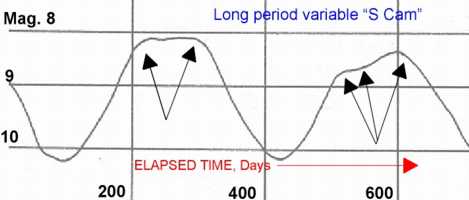
Most LPV's have a maximum peak that is fairly brief and quick to "round out" once achieving maximum and begin immediately fading again; the LPV stars are huge and very red pulsating giant stars whose pressure pushes the outer layers away from center (brighter) and eventually this expansion is overcome by gravity and the star's gasses are once again pulled back inward again (dimmer). Note that with S Cam, the typical maximum brightness, magnitude 8.1, is consistent, but it sometimes will remain there for up to 60 days....other times, such as the SECOND peak you see in the light curve above, there are minor fluctuations while at brightest. The MINIMA (around magnitude 10.8) is always very consistent and short-lived. This is an excellent star for all scopes, large and small. It can be seen throughout its 326-day cycle in even a 2" refractor, but good magnitude estimates (which are invited for submission the AAVSO, by the way!) should be done with somewhat larger instrument of high quality. Observe this star about once every two weeks to log YOUR estimate for an annual light curve of S Camelopardalis!
Object 6 - An Erratic "Dwarf Nova" - Z Camelopardalis
Here is a wild star as can be seen from the nearly 2-year light curve below:

This is a very cataclysmic star, erupting about every 2 to 3 weeks, but never so regularly that its next event can be accurately predicted! As can be seen, its rise to maximum - nearly 3 full magnitudes! - takes place in just over ONE DAY, as does its rapid demise once peaking out. The maximum nor minimum never lasts more than a couple of days at most. The star is a dwarf binary star system it is thought, with a cooler star so close that it gradually expels volatile gases from gravitational pull from a more massive and hotter star nearby....when these gases reach the outer layers of the hot star, the flare up violently and result in the remarkable brightening we see.
The range for this star keeps it well within reach of the ETX 125 and larger scopes, but it is a pretty difficult star to monitor regularly with the 3" scope, although it CAN be done. The maximum is typically a very consistent 10.1 or 10.3, while the minimum is always about the same - 13th magnitude. It is the period of outbursts of this star that are NOT predictable, and sharing YOUR estimates of this star's light changes is certainly encouraged by the AAVSO; unlike S Cam., this star should be observed at EVERY opportunity! It can go from a barely-seen speck of light to one of the brighter stars in your medium power field of view!
To locate the star and to observe it with comparison stars when it is at brightest, log on the AAVSO site again and download the "b" chart: charts.aavso.org/standard/CAM/Z_CAM/ZCAM-BR.GIF ;when the star is at dimmest, your will need: charts.aavso.org/standard/CAM/Z_CAM/ZCAM-DR.GIF . NOTE: unlike the charts for S Cam above, these charts are newer "Reversed" charts ("BR" and "DR" in those two URL's listed)....these are charts that the AAVSO has designed with today's modern telescope user in mind....the field of view MATCHES that of your catadioptic; in other words, North is at Top and East is always to the Left on the charts,just as in your telescope!
Object 7 - NGC 1502 - A Very Small, Compact Galactic Cluster with Two Double Stars!
This is a very irregular galactic cluster of loosely-associated stars. With a total magnitude of a seemingly bright 5.3, it is clearly visible in all scopes, but as a very small object compared with other larger star clusters. It is only 7' arc across and there are between 15 and 25 stars in a wide range of magnitudes associated with it. It is interesting to me because the star field surrounding ngc1502 is SO VOID of stars that this tiny cluster shows up distinctly like a small compact pile of diamonds on black velvet. This effect can clearly be seen in the Lowell Observatory photo below:
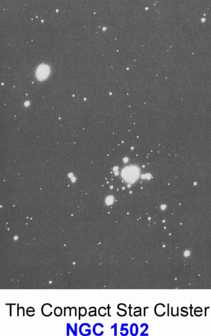
Note from this photo the wide range of star magnitudes. Indeed, two very easy and enjoyable double stars (actually one is a quadruple star!) are found within this cluster:
STRUVE 484 at: R.A. 04h 03' / DEC +62 12 (mags. 9.1 & 9.4, 5.3" arc apart - great in ETX 90!) and,
STRUVE 485 at: R.A. 04h 03' / DEC +62 12 (mags. 6, 6.1, 12.5 and 13!)
Both of these multiple star systems will be evident at medium to medium-high magnifications when you have zeroed in on the ngc1502. Most of the stars in this cluster are magnitude 8, but there are several brighter ones seen in the photograph; thus Struve 485, with its two primary stars (mag. 6 and 18" arc separation) should be clearly distinguishable in the cluster as one of the brighter stars....once found, look for Struve 484 immediately next to it, but as a much closer pair.
Object 8 - A Nice Bright Galaxy - VERY Large - NGC 2403
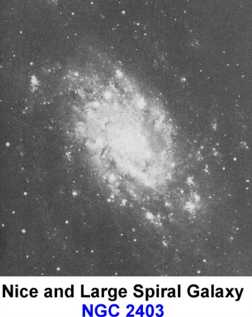
Size can be deceiving....particularly with "extended" celestial objects, those whose brightness is spread out over a very large area. For example the Andromeda galaxy is a bright magnitude 3, but that is what we call "total Integrated Magnitude", or the entire brightness of the object if every bit of it was compressed from its large size (nearly 2 degrees for M-31!) into the size of a star.
Thus, the large galaxy ngc2403 shown above in the U.S. Naval Observatory photograph has a total seemingly bright magnitude of 8.8 spread out over a field of view half the size of the full moon's apparent diameter - 17' arc! Nonetheless, this is a galaxy worth looking at...on a very dark night, use a nice wide field eyepiece at very low magnification to best see this object. Note the large "clumps" in the photograph which are large clusters of dense star groups in this spiral. With the ETX 125 and larger scopes these can be clearly seen with a magnification of about 100x. In 8" and larger telescopes this is a fine, and detail-filled object! In the ETX 70 and other wide field instruments - even binoculars! - look for this beautiful object as a large "glow" about 8 million light years away....some four times farther than the Andromeda galaxy.
Object 9 - NGC 2336 - very difficult except in 8" - A "many-armed" spiral galaxy!
This is a very difficult object, magnitude 11.0 visually, and fairly small (5.7' long by 2.8' wide). I am including it because this is a very worthy spiral galaxy for observation with 8, 10 and 12-inch telescopes and we have many readers in that size range. It can be seen distinctly in the ETX 125, but I cannot make out anything but a "fuzzy smudge", very faint and set in a fairly nice field of stars. However, in VERY dark conditions, observers with the 8" and larger telescope might glimpse unmistakable multiple arms of this galaxy, resembling as a very faint pattern of what we familiarly see in photographs of the famous "Pinwheel Galaxy."
Object 10 - Planetary Nebula, NGC 1501 - Nice Test for 5" Scope
This is not an easy object, but once found, it gets better the longer your eyes become acclimated to the surroundings. This round planetary nebula (remnants of a massive stellar explosion) is about the apparent size of Jupiter as seen in a medium-power eyepiece. Use about 200x to best view this bluish-green disklike object, and always observe only when the skies are very dark and without any moonlight. There is a central star (the one that created the nebula) of magnitude 13.4, but the nebula will obscure sighting of this star in the 5" scope, while the nebula itself should be clearly visible. In the 8" and larger telescopes, the central star is seen in fleeting glimpses, coming and going as conditions warrant. It is worth waiting for when that tiny speck of light that created this object "jumps out" and suddenly sparkles in your eye!
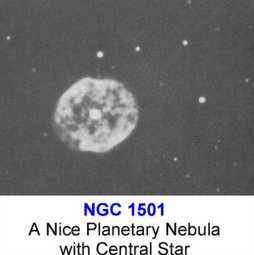
Although the central star for this planetary nebula - a shell of stellar gases emitted by the explosion of an unstable star - is bright enough for the ETX 125 limiting magnitude, it is VERY difficult to see visually except in larger telescopes; the reason is that there is much extraneous gases that block the visible wavelengths of light to the eye; averted vision in the LX 90 will reveal the star but only with a magnification of up to 400x and the darkest of nights. This star is plainly visible and appears erroneously "large" in the Palomar 200" photograph shown above.
Object 11 - Our Final Object - Planetary Nebula IC 3568
Here is another nice planetary nebula, one that is a bit brighter than the previous object. IC 3568 is about half the distance as ngc1501 but appears only 1/4 the size! (12" arc diameter). This very small green disk can be seen in the ETX 125 and perhaps only a bit better in the larger 8" scopes. However, it IS brighter (magnitude 11.6) and thus will hold increased magnification better than ngc1501. The central star of this planetary is ALSO visible as a magnitude 11.9 object and thus should be within reach of the 5" scope on a very steady dark night...normally an 11th magnitude star would be easily discernible with this scope, but the nebula - as explained above - obscures it for the most part. A trick to observing this - and all other central stars of planetary nebulae (try this on the Dumbbell, M-27, and the Ring, M-57!) is to use a good quality "nebula filter" which really isolates the nebula from the surrounding sky and stars....the central star will "pop out" at you!
----------------------------------
WANDERING ABOUT....YOUR NEW "USER OBJECT" IN CAMELOPARDALIS
We are going back to actually the BRIGHTEST star in Camelopardalis for our new "USER OBJECT" to input into the Autostar for this "GO TO" TOUR. No....we are not reverting back to Alpha Camelopardalis with which we started our TOUR, but to Beta Cam, which is actually the brightest of all objects in this constellation! At magnitude 4.2, it outshines Alpha by 0.2 magnitudes, so Bayer had his brightness classifications mixed up a bit, or his eyes were more blue-sensitive since Beta is a bit of an orange colored star.
Beta Cam (that sounds like an obsolete video device, doesn't it!?) is actually a very nice and easy triple star, even for smaller instruments as can be seen in my double star diagram below.
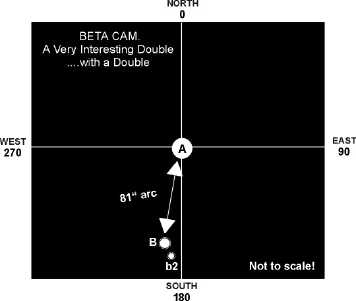
The primary star "A" is magnitude 4.2; the "B" companion is nearly due south in Position Angle 208 degrees from "A" a whopping 81" arc seconds distant. That spacing would require two Jupiters in your eyepiece to fill, so being too close is no excuse to NOT see this 9th magnitude star; in smaller telescopes, I recommend at least 75x to increase the image scale enough to see what will be a faint "B" star. In larger telescopes, use lower magnifications for best views. Now...the "b2" star companion is actually a companion to the "B" star....NOT the "A" star, so that is what makes this an unusual system! Look for "b2" as an 11th magnitude faint star (should be visible in the ETX 90, certainly so in the 5" and larger instruments) 15" arc also fairly south of the "B" star....not from "A" remember, but from the 9th magnitude companion to it!
Quite a challenge just keeping up with it! Certainly this will be a very interesting star for the 5" and larger scopes and likely for 3" telescopes as well. It is worth looking at, and worth remembering the facts.
Your will need to GO TO this star via its R.A. and DEC coordinates, just as we did for the Alpha starting star for this "GO TO" TOUR. The coordinates for Beta Cam are:
R.A. - 00 hours 59m
DEC. - + 60 degrees 22m
On AutoStar, go to: "Select/Object [enter]...." scroll down to "User Object" [ enter]. Now enter the coordinates given above for "beta Cam", using the number keys on AutoStar. After entering the coordinates and pressing "Enter" yet again, scroll down one and you can list the magnitude of the object as "4"[Enter].
This will provide you with yet another unique deep sky object for conversation-starters and crowd-stoppers at your next star party or club outing....NOT a true "triple star" but a double star with a third star that strings along!
Next Constellation GO TO" TOUR Installment: AURIGA, to me one of the most dramatic of all fall/winter constellations, with the majestic rising of Capella, the goat star with accompanying "kids" in the east on crisp fall nights. The clear and concise geometric outline of its stars invite one to explore the upcoming splendor of winter skies.
Good Observing and may the stars serve as your sentries as you explore the frontiers of space!
P. Clay Sherrod
Arkansas Sky Observatory
Conway / Petit Jean Mountain
Arkansas
Return to the top of this page.
Go back to the Observational Guides & References page.
Go back to my ETX Home Page.